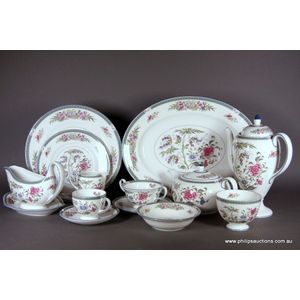Antique Mandarin Palette Cups and Saucers
You must be a subscriber, and be logged in to view price and dealer details.
Subscribe Now to view actual auction price for this item
When you subscribe, you have the option of setting the currency in which to display prices to $Au, $US, $NZ or Stg.
- Qing Dynasty - The Qing Dynasty was the last imperial dynasty of China, ruling from 1644 to 1912. It was established by the Manchu people, who originated from the northeastern region of China. The Qing Dynasty was preceded by the Ming Dynasty and followed by the Republic of China.
- Emeralds - Emeralds have been used in jewellery making for thousands of years, and are prized for their deep green colour, which is caused by the presence of chromium and vanadium in the mineral beryl. Because of their rare colour, emeralds are often more valuable than diamonds of a similar size and quality. In jewellery making, emeralds are typically cut into round or oval shapes to maximize their color and clarity. They are often set in gold or platinum and used as the centrepiece of a piece of jewellery, such as a ring or necklace. They can also be used in combination with other gems, such as diamonds, to create intricate and beautiful designs.
- Ming Dynasty - The Ming Dynasty was a ruling dynasty of China from 1368 to 1644. It succeeded the Yuan Dynasty and preceded the Qing Dynasty. The Ming Dynasty was established by Zhu Yuanzhang, a former Buddhist monk who became a rebel leader and eventually overthrew the Mongol Yuan Dynasty. During the Ming Dynasty, China experienced a period of relative stability and prosperity. The government was centralized and bureaucratic, with the emperor at the top of the hierarchy. The Ming Dynasty is known for its cultural achievements, including the development of porcelain, the invention of movable type printing, and the construction of the Great Wall of China.
- Mandarin Palette - The Mandarin palette is a decorative style used to decorate Chinese export porcelain, which was produced in China specifically for export to Europe and other parts of the world from the 16th to the 19th century. The Mandarin palette is characterized by a bright and colourful design featuring various figures, landscapes, and ornamental motifs.
The Mandarin palette was first used during the reign of the Kangxi Emperor (1662-1722) in the Qing dynasty. It was named after the Mandarin officials who were depicted in the designs, wearing their distinctive robes and hats. The palette was popular among European collectors and was often used to decorate tea services, vases, and other decorative objects.
The Mandarin palette was made up of a limited number of colours, typically blue, green, pink, and gold. The designs often featured figures in a garden setting, surrounded by trees, rocks, and pavilions. Some of the most popular motifs included dragons, birds, flowers, and auspicious symbols, such as bats and peaches.
The Mandarin palette remained popular throughout the Qing dynasty and was used to decorate a wide range of Chinese export porcelain. It continued to be popular among European collectors into the 19th century, and its influence can be seen in the work of many European ceramic artists of the time.
This item has been included into following indexes:
-
Chinese ceramics, item type
- cups, cups & saucers 302
- figurines 1,568
- saucers 261
Visually similar items

A Ridgway coffee cup and saucer and a Spode 'Broseley' pattern coffee cup and saucer, the first circa 1815, decoration pattern 2/147, the other circa 1820, both cups London-shape, the Ridgway set with gilt and reserved white decoration of flowers and folia

A Sixty seven piece Wedgwood 'Kingston' dinner service 1981-1987, production period, pattern 4677, comprising: nine dinner plates, seven entree plates, seven soup coupes and six saucers, eight side plates and eight dessert bowls, seven cups and saucers, a

A pair of small Chinese dishes, a blue and white tea bowl and saucer, Qing Dynasty, 19th century, a pair of underglaze blue dishes in the Qianlong manner decorated with polychrome enamel flowers with gilt enrichments to the centre, a small dish with a peon

A group of Chinese porcelain wares 6pcs i) two famille rose cups decorated with mythical dragon and phoenix, with six character marks to base, height 5.5 cm ii) two famille rose dishes with spoons dish diameter 16 cm
